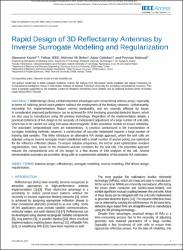| dc.contributor.author | Koziel, Slawomir | |
| dc.contributor.author | Belen, Mehmet Ali | |
| dc.contributor.author | Çalışkan, Alper | |
| dc.contributor.author | Mahouti, Peyman | |
| dc.date.accessioned | 2023-12-13T12:53:01Z | |
| dc.date.available | 2023-12-13T12:53:01Z | |
| dc.date.issued | 2023 | en_US |
| dc.identifier.citation | Koziel, S., Belen, M.A., Caliskan, A., Mahouti, P. (2023). Rapid Design of 3D Reflectarray Antennas by Inverse Surrogate Modeling and Regularization. IEEE Access, 11, pp. 24175-24184. | en_US |
| dc.identifier.uri | https://hdl.handle.net/20.500.12508/2650 | |
| dc.description.abstract | Reflectarrays (RAs) exhibit important advantages over conventional antenna arrays, especially in terms of realizing pencil-beam patterns without the employment of the feeding networks. Unfortunately, microstrip RA implementations feature narrow bandwidths, and are severely affected by losses. A considerably improved performance can be achieved for RAs involving grounded dielectric layers, which are also easy to manufacture using 3D printing technology. Regardless of the implementation details, a practical bottleneck of RA design is the necessity of independent adjustment of a large number of unit cells, which has to be carried out using full-wave electromagnetic (EM) simulation models to ensure reliability. The associated computational costs are extraordinary. A practical workaround is the incorporation of surrogate modeling methods; however, a construction of accurate metamodel requires a large number of training data samples. This letter introduces an alternative RA design approach, where the unit cells are adjusted using an inverse surrogate model established with a small number of anchor points, pre-optimized for the reference reflection phases. To ensure solution uniqueness, the anchor point optimization involves regularization, here, based on the minimum-volume condition for the unit cell. The presented approach reduces the computational cost of RA design to a few dozens of EM analyses of the cell. Several demonstration examples are provided, along with an experimental validation of the selected RA realization. | en_US |
| dc.language.iso | eng | en_US |
| dc.publisher | Institute of Electrical and Electronics Engineers Inc. | en_US |
| dc.relation.isversionof | 10.1109/ACCESS.2023.3254204 | en_US |
| dc.rights | info:eu-repo/semantics/openAccess | en_US |
| dc.subject | Antenna design | en_US |
| dc.subject | EM-driven design | en_US |
| dc.subject | Inverse modeling | en_US |
| dc.subject | Reflectarrays | en_US |
| dc.subject | Regularization | en_US |
| dc.subject | Surrogate modeling | en_US |
| dc.subject.classification | Electrical Engineering, Electronics & Computer Science - Wireless Technology - Pattern Synthesis | |
| dc.subject.classification | Dual-Band | |
| dc.subject.classification | Antenna | |
| dc.subject.classification | Superhigh Frequencies | |
| dc.subject.other | Antenna arrays | |
| dc.subject.other | Cells | |
| dc.subject.other | Cost benefit analysis | |
| dc.subject.other | Cytology | |
| dc.subject.other | Inverse problems | |
| dc.subject.other | Optical design | |
| dc.subject.other | Antenna design | |
| dc.subject.other | Computational modelling | |
| dc.subject.other | Electromagnetic-driven design | |
| dc.subject.other | Electromagnetics | |
| dc.subject.other | Inverse modelling | |
| dc.subject.other | Optimisations | |
| dc.subject.other | Reflectarrays | |
| dc.subject.other | Reflector antennas | |
| dc.subject.other | Regularisation | |
| dc.subject.other | Surrogate modeling | |
| dc.subject.other | Computational efficiency | |
| dc.title | Rapid Design of 3D Reflectarray Antennas by Inverse Surrogate Modeling and Regularization | en_US |
| dc.type | article | en_US |
| dc.relation.journal | IEEE Access | en_US |
| dc.contributor.department | Mühendislik ve Doğa Bilimleri Fakültesi -- Elektrik-Elektronik Mühendisliği Bölümü | en_US |
| dc.identifier.volume | 11 | en_US |
| dc.identifier.startpage | 24175 | en_US |
| dc.identifier.endpage | 24184 | en_US |
| dc.relation.publicationcategory | Makale - Uluslararası Hakemli Dergi - Kurum Öğretim Elemanı | en_US |
| dc.contributor.isteauthor | Belen, Mehmet Ali | |
| dc.relation.index | Web of Science - Scopus | en_US |
| dc.relation.index | Web of Science Core Collection - Science Citation Index Expanded | |
















